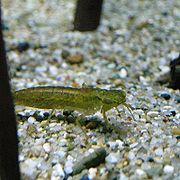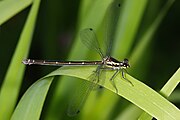Dragonfly
From Wikipedia, the free encyclopedia
| It has been suggested that Epiprocta be merged into this article or section. (Discuss) |
| Dragonfly | ||||||||||||
|---|---|---|---|---|---|---|---|---|---|---|---|---|
 |
||||||||||||
| Scientific classification | ||||||||||||
|
||||||||||||
| Families | ||||||||||||
|
Aeshnidae |
A dragonfly is a type of insect belonging to the order Odonata, the suborder Epiprocta or, in the strict sense, the infraorder Anisoptera. It is characterized by large multifaceted eyes, two pairs of strong transparent wings, and an elongated body. Dragonflies are similar to damselflies, but the adults can be differentiated by the fact that the wings of most dragonflies are held away from, and perpendicular to, the body when at rest. Even though dragonflies possess 6 legs like any other insect, they are not capable of walking.
Dragonflies are valuable predators that eat mosquitoes, and other small insects like flies, bees, ants and butterflies. They are usually found around lakes, ponds, streams and wetlands because their larvae, known as "nymphs", are aquatic.
Nymphs can deliver a painful bite when threatened. Be sure to clean the bite thoroughly to prevent water-borne infections.
Contents |
[edit] Life cycle

Female dragonfly lay eggs in or near water, often on floating or emergent plants. When laying eggs, some species will submerge themselves completely in order to lay their eggs on a good surface. The eggs then hatch into nymphs. Most of a dragonfly's life is spent in the naiad (that is, nymph) form, beneath the water's surface, using extendable jaws to catch other invertebrates or even vertebrates such as tadpoles, fish, etc. They breathe through gills in their rectum, and can rapidly propel themselves by suddenly expelling water through the anus.[1] Some nymphs even hunt on land,[2] an aptitude which could easily have been more common in ancient times when terrestrial predators were clumsier.
The larval stage of large dragonflies may last as long as five years. In smaller species, this stage may last between two months and three years. When the larva is ready to metamorphose into an adult, it climbs up a reed or other emergent plant. Exposure to air causes the larvae to begin breathing. The skin splits at a weak spot behind the head and the adult dragonfly crawls out of its old larval skin, pumps up its wings, and flies off to feed on midges and flies. The adult stage of larger species of dragonfly can last as long as four months.
[edit] Classification (Anisozygoptera)
Formerly, the Anisoptera were given suborder rank beside the "ancient dragonflies" (Anisozygoptera) which were believed to contain the two living species of the genus Epiophlebia and numerous fossil ones. More recently it turned out that the "anisozygopterans" form a paraphyletic assemblage of morphologically primitive relatives of the Anisoptera. Thus, the Anisoptera (true dragonflies) are reduced to an infraorder in the new suborder Epiprocta (dragonflies in general). The artificial grouping Anisozygoptera is disbanded, its members being largely recognized as extinct offshoots at various stages of dragonfly evolution. The two living species formerly placed there — the Asian relict dragonflies — form the infraorder Epiophlebioptera alongside the Anisoptera.
[edit] Dragonflies and damselflies
Damselflies (suborder Zygoptera) are often confused with dragonflies, but these are distinct; most damselflies hold their wings at rest together above the torso or held slightly open above (such as in the family Lestidae), whereas most dragonflies at rest hold their wings horizontally or occasionally slightly down and forward. Also, the back wing of the dragonfly broadens near the base, caudal to the connecting point at the body, while the back wing of the damselfly is similar to the front wing. The eyes on a damselfly are apart; in most dragonflies the eyes touch. Notable exceptions are the Petaluridae (Petaltails) and the Gomphidae (Clubtails).
[edit] Common species
[edit] Northern Hemisphere
|
|
[edit] Southern Hemisphere
|
|
|
[edit] Dragonflies in culture
In Europe, dragonflies have often been seen as sinister. Some English vernacular names, such as "devil's darning needle" and "ear cutter", link them with evil or injury.[3] A Romanian folk tale says that the dragonfly was once a horse possessed by the devil. This is also seen in the Maltese culture as the word for dragonfly which is "Debba ta' l-infern" literally means Hell's mare. Swedish folklore holds that the devil uses dragonflies to weigh people's souls.[4] Another Swedish legend holds that trolls use the dragonflies as spindles when weaving their clothes (hence the Swedish word for dragonfly trollslända, lit. "troll's spindle") as well as sending them to poke out the eyes of their enemies.[citation needed] The Norwegian name for dragonflies is "Øyenstikker", which literally means Eye Poker and in Portugal they are sometimes called "Tira-olhos" (Eye snatcher). They are often associated with snakes, as in the Welsh name gwas-y-neidr, "adder's servant".[3] The Southern United States term "snake doctor" refers to a folk belief that dragonflies follow snakes around and stitch them back together if they are injured.[5] The Lithuanian word "Laumžirgis" is a composite word meaning "the Lauma's horse", while in Dutch, Aeshna mixta is called "Paardenbijter" or "horse biter". In some South American countries, dragonflies are also called matacaballo (horse killer), or caballito del diablo (devil's little horse), since they were perceived as harmful, some species being quite large for an insect.
In East Asia and among Native Americans, dragonflies have a far better reputation, one that can also be said to have positively influenced modern day views about dragonflies in most countries, in the same vein as the insect's namesake, the dragon, which has a positive image in the east,[citation needed] but initially had an association with evil in the west.
For some Native American tribes they represent swiftness and activity, and for the Navajo they symbolize pure water. Dragonflies are a common motif in Zuni pottery; stylized as a double-barred cross, they appear in Hopi rock art and on Pueblo necklaces.[6] It is said in some Native American beliefs that dragonflies are a symbol of renewal after a time of great hardship.
They also have traditional uses as medicine in Japan and China. In some parts of the world they are a food source, eaten either as adults or larvae; in Indonesia, for example, they are caught on poles made sticky with birdlime, then fried in oil as a delicacy.[3]
Vietnamese people have a traditional way to forecast rain by seeing dragonflies: "Chuồn chuồn bay thấp thì mưa, bay cao thì nắng, bay vừa thì râm" (Dragonflies fly at low level, it is rainy; dragonflies fly at high level, it is sunny; dragonflies fly at medium level, it is shadowy).
In some parts of the world it is considered lucky to have a dragonfly land on you, even to the point of yielding seven years of good luck.
In the United States dragonflies and damselflies are sought out as a hobby similar to birding and butterflying, known as oding, from the dragonfly's Latin species name, odonata. Oding is especially popular in Texas, where 225 out of a total of 457 known species of odonates in the world have been observed. With care, dragonflies can be handled and released by Oders, unlike butterflies.[7]
Images of dragonflies were common in Art Nouveau, especially in jewelry designs.[8] They have also been used as a decorative motif on fabrics and home furnishings.[9]
[edit] Japan
In Japan dragonflies symbolize "martial success," due to similarity in the sound of the word "dragonfly" and "victory" in Japanese. As a seasonal symbol, the dragonfly is associated with late summer and early autumn.[10]
More generally, in Japan dragonflies are symbols of courage, strength, and happiness, and they often appear in art and literature, especially haiku. In ancient mythology, Japan was known as Akitsushima, which means "Land of the Dragonflies". The love for dragonflies is reflected by the fact that there are traditional names for almost all of the 200 species of dragonflies found in and around Japan.[11] Japanese children catch large dragonflies as a game, using a hair with a small pebble tied to each end, which they throw into the air. The dragonfly mistakes the pebbles for prey, gets tangled in the hair, and is dragged to the ground by the weight.[12]
Also, in Japan, amongst the Three Great Spears of Japan is one which is called the Tonbogiri, which when translated is called 'The Dragon Fly Cutter'. The spear is an important part of Japan's imperial regalia - the spear itself was once wielded by the legendary Samurai, Honda Tadakatsu. Its name is derived from the story that the blade is so sharp, a dragonfly once landed on it and was instantly cut in half.
[edit] Gallery
|
Dragonfly from Florida. Yellow and blue that have a tatu on the tail |
Green Darner Dragonfly feeding on honey bee |
||
|
The compound eyes of a dragonfly |
|||
|
Emperor dragonfly in Greece |
[edit] See also
[edit] References
- ^ Waldbauer, Gilbert (2006). A Walk Around the Pond: Insects in and Over the Water. Harvard University Press. pp. 105. ISBN 9780674022119. http://books.google.com/books?id=WtUc-YdjZzgC&pg=PA105&lpg=PA105&dq=dragonfly+nymph+water+rectum&source=web&ots=j2hvxI_vHC&sig=D4hXLuWtQAJUW7WIISfMY_K201s#PPA105,M1.
- ^ Grzimeck, HC; Bernard (1975). Grzimek's Animal Life Encyclopedia Vol 22. Detroit: Visible Ink Press. pp. 348.
- ^ a b c Corbet, Phillip S. (1999). Dragonflies: Behavior and Ecology of Odonata. Ithaca, NY: Cornell University Press. pp. 559–561. ISBN 0-8014-2592-1.
- ^ Mitchell, Forrest L.; James L. Lasswell (2005). A Dazzle of Dragonflies. College Station, TX: Texas A&M University Press. pp. 25–27. ISBN 1-585-44459-6.
- ^ Hand, Wayland D. (1973). "From Idea to Word: Folk Beliefs and Customs Underlying Folk Speech". American Speech 48 (1/2): 67–76. doi:. http://links.jstor.org/sici?sici=0003-1283(197321%2F22)48%3A1%2F2%3C67%3AFITWFB%3E2.0.CO%3B2-Y. Retrieved on 2007-02-15.
- ^ Mitchell and Lasswell, 20-26.
- ^ "Dragonflying: The new birding" by Tracy Hobson Lehmann San Antonio Express-News June 19, 2008
- ^ Moonan, Wendy (August 13, 1999). "Dragonflies Shimmering as Jewelry". New York Times: pp. E2:38. ProQuest document ID 43893085.
- ^ Large, Elizabeth (June 27, 1999). "THE LATEST BUZZ; In the world of design, dragonflies are flying high". The Sun (Baltimore, MD): pp. 6N. ProQuest document ID 42880564.
- ^ Baird, Merrily (2001). Symbols of Japan: Thematic Motifs in Art and Design. New York: Rizzoli. pp. 108-9. ISBN 0-8478-2361-X.
- ^ Waldbauer, Gilbert (1998). The Handy Bug Answer Book. Detroit: Visible Ink Press. pp. 91. ISBN 1-57859-049-3.
- ^ Mitchell and Lasswell, 38.
justine loves dragonflies shes totally obsessed with them and is soon getting a large tattoo of one on her back!
[edit] External links
| Wikimedia Commons has media related to: Dragonfly |
- Tree of Life Odonata
- Dragonfly at the Open Directory Project
- Identification key to dragonflies found in Ireland
- British Dragonfly Society
- Dragonflies and Damselflies (Odonata) of the United States
- PHAON (Pinhey's Heritage African Odonata Network)
- Dragonflies in folklore and art
- dragonflies and damselflies on the UF / IFAS Featured Creatures Web site
































